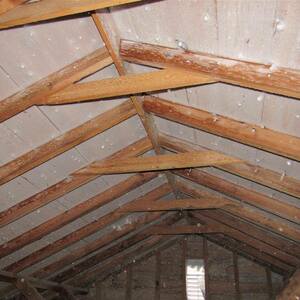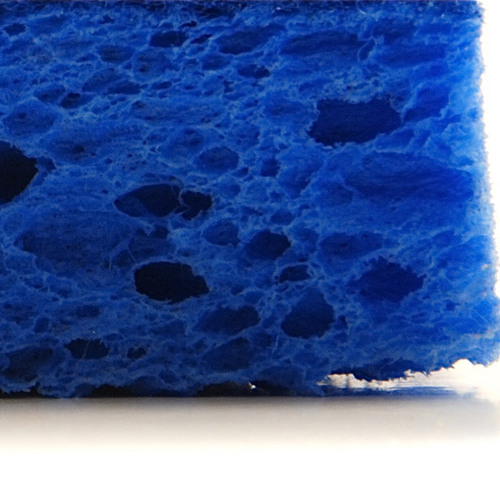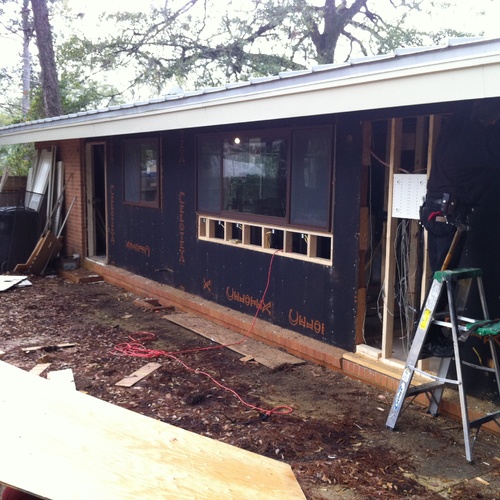
Every few months, GBA gets a question from a cold-climate builder who discovers sheathing moisture while installing wall insulation — often in a walkout basement. Here’s the scenario: the builder is installing fiberglass batts in some of his home’s stud bays during cold weather. The next day, he happens to peel back some of the batts and is shocked to discover that the OSB sheathing is soaked. He panics. What should he do now?
At least six GBA readers have posted questions on this topic over the years. Looking for common threads in these cases, I noticed:
- All six cases occurred in cold climates — specifically, Maine, Massachusetts, Michigan, Minnesota, New York, Washington, and Wisconsin.
- In all six cases, the insulation was fibrous insulation (either fiberglass batts or mineral wool batts).
- In all six cases, the walls were not yet covered with drywall.
- Four cases occurred in an area described as a “walkout basement” or “half basement”; one case happened in a room over a garage, and one case occurred in a closet.
- In all cases, there was reason to believe that the indoor relative humidity was elevated, due either to construction moisture (typically, a freshly poured basement slab) or the operation of a humidifier.
Tales of woe
Tony Bouchard of Cornish, Maine, was installing mineral wool insulation in the stud bays of a room over his garage. “I noticed a small wet spot on the floor in one corner; it is about the size of a credit card,” Bouchard wrote. “No idea how that got there, so I started poking around and found… the exterior sheathing behind the insulation was really wet. … On the same wall I have a half-insulated stud bay. The open half is dry, but under the insulation the sheathing is all wet.”
David Schreiber of…
Weekly Newsletter
Get building science and energy efficiency advice, plus special offers, in your inbox.

This article is only available to GBA Prime Members
Sign up for a free trial and get instant access to this article as well as GBA’s complete library of premium articles and construction details.
Start Free TrialAlready a member? Log in















15 Comments
Physics at work indeed. One of the "Tales" mentions a salamander temporary heater, and I think it's worth repeating that as a contributor to high indoor humidity. Get yourself a temporary propane heater that can vent out a window. You won't be able to avoid a problem if you dump dozens of gallons of water into the air every day during rough-in, insulation and drywall phases.
And I think the vapor barrier that likely will be installed behind the drywall in these climates deserves a mention. If the work plows ahead despite some (or a lot of) water on the sheathing, rather than the conventional polyethylene, best to switch to a smart vapor retarder that will allow some drying to the inside.
Thanks, Martin!
Li Ling Young,
In my article, I wrote, "It’s also a good idea to turn up the heat (as long as the heater doesn’t introduce moisture into the building)." But thanks for underlining my advice.
Building inspectors can stop a project when mold is present calling for remediation, gets to be a mess. Recently poured concrete floors are the major source of excess humidity in new buildings. Even worse than OSB for mold formation during construction is paper faced gypsum drywall exterior sheathing often used on commercial projects.
This is becoming more and more of an issue as we build more air-tight. Once most of the air barrier is done, but before the ventilation system is running - which is a good many months of worker sweat and moisture-laden materials being brought in - these buildings get absolutely loaded with water. I've taken to recommending cracking the windows and/or dehumidifiers during construction, regardless of the season. Air quality during construction can be an issue too, dust & vapors linger a lot longer.
After I wrote an article for Fine Homebuilding about flash-and-batt insulation in 2011, I heard from at least two different people that they were getting condensation on the face of the foam, even with "safe" ratios of foam-to-fiberglass R-value. My advice was similar to yours: stop using propane or kerosene heaters indoors, due to the large amounts of water they exhaust (not to mention the carbon monoxide and other dangerous compounds), pull out the fiberglass and let the foam dry, then install new fiberglass and get it covered as quickly as possible.
Martin,
I understand and appreciate all the different perspectives regarding constructing the perfect wall for a given climate zone. But if you were to build the perfect wall the expense become somewhat burdensome. My question is how you balance this additional cost against the relative benefit. In my situation I am constructing a new house near Buffalo New York which is Zone 5. I am currently planning on building a 2 x 6 exterior wall (with advanced framing either 16 or 24- inch on center) with dense packed (cellulose or fiberglass) insulation which would have an R-value of 22-23. Now I have created cold exterior sheathing which would require a minimum exterior foam insulation of at least 1.5 inch (or more) assuming XPS. The problem becomes the direct application of the James Hardie cement board siding which can only be nailed through 1- inch foam unless strapping is utilized. Now you add in the cost of the 1X4 strapping which does create a rain screen and add ventilation. Then the windows would be shimmed out over 2 inches and integrated into the weather barrier. An easy upgrade would be to substitute plywood for OSB and scratch the foam exterior insulation. Another cost-effective alternative would be to use a weather barrier with integrated rain screen such as Tyvek drain wrap. I am planning on taping the joints of the exterior sheathing. Also, there would be a good drywall air barrier on the interior. To complicate matters further there will be a 9.5 KV solar array on the south facing elevation so I’ll have plenty of energy to heat and cool the house. In closing my question is, how does someone build the most cost-effective perfect wall. Thanks in advance for your assistance.
Tom Hagner
Thomas,
I wish there was a simple answer to your question, but there isn't. I think it's great to design a wall that addresses thermal bridging through the studs -- and that means either (a) the use of continuous insulation on the exterior side of the sheathing -- and therefore (usually) furring strips, or (b) a double-stud wall.
Do these options cost more? Of course. Do they perform better than an ordinary 2x6 wall? Clearly. Can you afford a better wall? I don't know.
For more information, see this article: "How to Design a Wall."
Martin,
I came across a product for covering XPS insulation above grade called Groundbreaker by NUDO. It is a fiberglass reinforced panel (FRP) which is typically utilized in very wet application such as commercial bathrooms and kitchens. Does anyone have any experience utilizing this product for covering exposed above grade foundation insulation?
Thanks Tom Hagner
Thomas,
You may want to read this article: "How to Insulate a Basement Wall."
In that article, I list the Ground Breaker product from Nudo as one way to protect rigid foam install on the exterior of a foundation wall. (You can scroll down to the section of my article that begins, "If I insulate on the outside, how should I protect the above-grade foam?")
I haven't used the product myself. But my article is 6 years old, and I haven't heard any negative comments on Ground Breaker from GBA readers since I published the advice. If you like the looks of Ground Breaker, go ahead and use it.
Keep in mind Thomas, your whole wall will not be R22-23. Even with 24" on center you have a lot of heat radiating out through the studs without exterior insulation. Energy costs will always rise, so I'd take the investment of exterior insulation and strapping which instantly start saving you money.
What a timely post. I'm almost ready for insulation for my first new build in SE Michigan, zone 5. The building inspector recommended "drying" the home out before drywall installation. He said most guys install fiberglass then run the furnace to sufficiently 'dry out' the home. I was curious how long this normally takes and what would constitute the home being dry enough?
What you are primarily concerned about being dry before encapsulating them are the wood structural members and sheathing. Using a pin-moisture meter might be a good way to know when it was safe to go ahead.
Tom,
I don't have any rules of thumb, frankly -- I've always used common sense -- but I'm interested in the comments of other GBA readers.
You can start out by purchasing and installing a couple of hygrometers to monitor the indoor relative humidity. Watch what happens as you operate your furnace.
If you see condensation on the interior of your windows in cold weather, that's a sign that the interior of your home is still humid. Ventilation and heat will help lower the indoor RH.
So as I stated approx one month ago, we were almost ready for drywall in a new build in Michigan. As luck would have it, I passed my rough inspections and insulation was underway during a cold spell here in Michigan. While I was at work, the furnace was repaired by the HVAC company, and the furnace ran for almost 24 hours before I could get to the site. Once there, it was 70 and sunny inside. We had all the walls meticulously insulated with fiberglass.....when I reached behind the batts.....wet!
Condensation had formed and several of the walls were icy. I pulled almost all the batts back to air out and they dried in a few hours. I turned the furnace down to low ( approx 50 degrees). I have fans going and I'll be putting a dehumidifier in the basement.
Oddly enough, the sun was out during the day, and the south and west walls did not have condensation, I'm assuming due to the warmer sheathing (Zip).
Am I correct to turn the heat down to lower the dew point? I have my insulation inspection on Tuesday, drywall arrives wed. I'll be monitoring and agonizing over these details until then. We also have very cold weather forecasted for the next few days, highs only in the teens.
I have a similar during construction question. I'm working on an upstairs room remodel, in climate zone 7/8 (Homer AK, so coastal and warmer than interior AK, but we do get cold spikes). We had to tear out all the drywall anyway and exterior insulation/detailing would have been difficult in our situation (not enough roof overhang), so we decided to go with Flash and Batt to improve insulation in the existing space. The wall outside in, is (or will be) New siding, housewrap, existing T1-11, 2x6 walls, spray foam (2.5"), R-19 Batts, drywall, paint.
The Spray foam step is complete, we put up the batt, and within a couple days we had a cold weather spell, and it got quite wet behind the batts. It is a DIY "winter project" for us, so we wanted to get the insulation done fast, and take our time getting drywall and detailing done. Question, would it make sense to also install Tyvek on the interior as a fast "temporary" air barrier (although I'm not sure we'd need to remove it?) While we do the drywall work on nights and weekends over the next couple months.
Thanks!
Log in or become a member to post a comment.
Sign up Log in